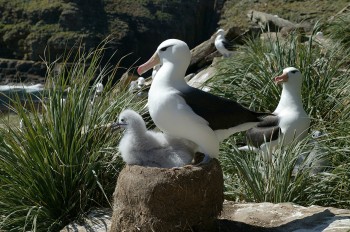Miguel Ferrer (Applied Ecology Group, Estación Biológica de Doñana, Seville, Spain) and Virginia Morandini have published in the journal Polar Biology on tick infestations on Black-browed Albatross Thalassarche melanophris chicks on the Falkland Islands/ Islas Malvinas*.
The short note’s abstract follows:
“The tick Ixodes uriae is an ectoparasite widely distributed among seabirds throughout circumpolar regions, usually associated with seabird colonies. Nevertheless, potential effects of infestations, especially in chicks, are not well documented. In this article, we studied factors associated with probability and intensity of infestations in Black-browed Albatross Thalassarche melanophrys [sic] nestlings in a colony at the Falklands Islands. We compared the body measurements, physiological parameters, distance to other nests and position inside the colony between infested and non-infested 40 Black-browed Albatross nestlings. Ticks were present in 60% of the nestlings with a mean number per nestlings of 1.47. None of the 12 analysed blood parameters but LDH (Lactate dehydrogenase) showed significant differences between infested and not infested nestlings. Nestlings infected showed significant higher level of LDH than those without ticks. The number of ticks found on each nestling was positively and significantly correlated with their LDH blood levels. Tarsus length (as a proxy of age) and distance to the nearest nest showed a significant effect, with younger nestlings with closer nests showing higher probability to be infected. These variables also affect intensity of infestation. No effects of nutritional condition (butyrate or urea levels) or body condition (residuals of cubic root of mass/tarsus length regression) on probability or intensity of infestation were found. Both small anaemias and tick scars would explain the different values of LDH between infected/non-infected chicks. The low level of infestation found in our colony could be the cause of a non-detectable effect of the presence of ticks on nestling body condition and other blood parameters related to metabolism of fat or protein.”

A Black-browed Albatross stands over its chick on New Island, photograph by Ian Strange
Reference:
Ferrer, M. & Morandini, V. 2019. Tick infestations correlates at a Falkland Islands Black-browed Albatross colony. Polar Biology doi.org/10.1007/s00300-018-02445-5.
John Cooper, ACAP Information Officer, 09 January 2019
*A dispute exists between the Governments of Argentina and the United Kingdom of Great Britain and Northern Ireland concerning sovereignty over the Falkland Islands (Islas Malvinas), South Georgia and the South Sandwich Islands (Islas Georgias del Sur y Islas Sandwich del Sur) and the surrounding maritime areas.

 English
English  Français
Français  Español
Español